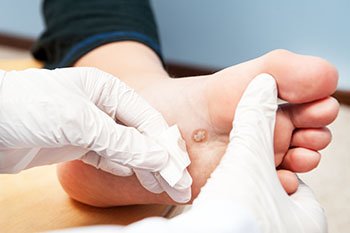Items filtered by date: February 2023
What Is Ledderhose Disease?

Hard lumps that form on the soles of the feet may be indicative of Ledderhose disease. Ledderhose disease is considered to be a rare foot condition that affects the plantar fascia. The plantar fascia is the band of tissue connecting the heels to the toes and may cause pain while walking. The lumps that form are generally benign and typically affect people middle-aged and older. The ankle joints may be uncomfortable, and a tingling sensation may be felt. The exact reason this foot condition develops is unknown, however, people with certain medical ailments may be prone to Ledderhose disease. These can include diabetic patients, people who consume excess alcohol, and those who take specific medications. Wearing custom-made orthotics may help to relieve pressure on the bottom of the feet. If you have pain in the sole of your foot, it is suggested that you consult with a podiatrist who can diagnose Ledderhose disease and offer the correct treatment options.
Some foot conditions may require additional professional care. If you have any concerns, contact the foot specialists of Spartan Podiatry. Our doctors can provide the care you need to keep you pain-free and on your feet.
Rare Foot Conditions
The majority of foot conditions are common and can be treated by a podiatrist. Standard diagnostic procedures are generally used to identify specific conditions and treatment can be rendered. A podiatrist also treats rare foot conditions which can be difficult to diagnose and may need extra attention and care.
There are many rare foot conditions that can affect children. Some of these can include:
- Freiberg’s disease
- Kohler’s disease
- Maffucci syndrome
Freiberg’s disease - This can be seen as a deterioration and flattening of a metatarsal bone that exists in the ball of the foot. It typically affects pre-teen and teenage girls, but can affect anyone at any age. Symptoms that can accompany this can be swelling, stiffness, and the patient may limp.
Kohler’s disease - This often targets the bone in the arch of the foot and affects younger boys. It can lead to an interruption of the blood supply which ultimately can lead to bone deterioration. The patient may limp or experience tenderness, swelling, and redness.
Maffucci syndrome - This affects the long bones in a child’s foot leading to the development of abnormal bone lesions. They are benign growths and typically develop in early childhood and the bones may be susceptible to breaking.
A podiatrist can properly diagnose and treat all types of rare foot conditions. If your child is affected by any of these symptoms or conditions, please don’t hesitate to call our office so the correct treatment method can begin.
If you have any questions please feel free to contact our offices located in Battle Creek, and Marshall, MI . We offer the newest diagnostic tools and technology to treat your foot and ankle needs.
Are You Suffering From Nerve Damage?
Where Is a Plantar Wart Found?

Plantar warts can cause a considerable amount of pain and discomfort. They occur when the human papillomavirus, which is abbreviated as HPV, enters the body through small cracks in the skin on the feet. They are found on the soles of the feet and grow inward as a result of the weight the feet endure while walking and running, possibly causing severe pain. A plantar wart is a small bump with a rough consistency, and it often has small black dots in the center. Certain people may be prone to getting a plantar wart, including people who have a weakened immune system, or it may come from sharing shoes, towels, and socks. There are various treatment methods that can be used on plantar warts, and it is suggested that you confer with a podiatrist who can determine what the best course of treatment is for you.
Plantar warts can be very uncomfortable. If you need your feet checked, contact the foot specialists from Spartan Podiatry. Our doctors will assist you with all of your foot and ankle needs.
About Plantar Warts
Plantar warts are the result of HPV, or human papillomavirus, getting into open wounds on the feet. They are mostly found on the heels or balls of the feet.
While plantar warts are generally harmless, those experiencing excessive pain or those suffering from diabetes or a compromised immune system require immediate medical care. Plantar warts are easily diagnosed, usually through scraping off a bit of rough skin or by getting a biopsy.
Symptoms
- Lesions on the bottom of your feet, usually rough and grainy
- Hard or thick callused spots
- Wart seeds, which are small clotted blood vessels that look like little black spots
- Pain, discomfort, or tenderness of your feet when walking or standing
Treatment
- Freezing
- Electric tool removal
- Laser Treatment
- Topical Creams (prescription only)
- Over-the-counter medications
To help prevent developing plantar warts, avoid walking barefoot over abrasive surfaces that can cause cuts or wounds for HPV to get into. Avoiding direct contact with other warts, as well as not picking or rubbing existing warts, can help prevent the further spread of plantar warts. However, if you think you have developed plantar warts, speak to your podiatrist. He or she can diagnose the warts on your feet and recommend the appropriate treatment options.
If you have any questions please feel free to contact our offices located in Battle Creek, and Marshall, MI . We offer the newest diagnostic and treatment technologies for all your foot and ankle needs.
Foot and Ankle Injuries in Pickleball
 The increasingly popular sport of pickleball was born from a cross between tennis, badminton and ping-pong. 2022 marked the 57th anniversary of this sport. It has grown in participation because it is fun and older participants especially think it is easier on the body. However, those who play this sport are still at risk for injury to various parts of their bodies. The quick side-to-side movements in pickleball put the ankle joint at high risk for sprain injuries. The repeated pounding of the feet on hard courts can also lead to foot pain. Investing in good, stable court shoes with a large toe box can help offset some of the pain suffered. Also, increasing the strength of the foot and ankle by practicing balancing exercises on one foot at a time can help in the prevention of injuries. If you are a pickleball player and have sustained an injury or suffer from foot pain, contact a podiatrist who can help with proper diagnoses and treatments appropriate for you.
The increasingly popular sport of pickleball was born from a cross between tennis, badminton and ping-pong. 2022 marked the 57th anniversary of this sport. It has grown in participation because it is fun and older participants especially think it is easier on the body. However, those who play this sport are still at risk for injury to various parts of their bodies. The quick side-to-side movements in pickleball put the ankle joint at high risk for sprain injuries. The repeated pounding of the feet on hard courts can also lead to foot pain. Investing in good, stable court shoes with a large toe box can help offset some of the pain suffered. Also, increasing the strength of the foot and ankle by practicing balancing exercises on one foot at a time can help in the prevention of injuries. If you are a pickleball player and have sustained an injury or suffer from foot pain, contact a podiatrist who can help with proper diagnoses and treatments appropriate for you.
Sports related foot and ankle injuries require proper treatment before players can go back to their regular routines. For more information, contact the foot specialists of Spartan Podiatry. Our doctors can provide the care you need to keep you pain-free and on your feet.
Sports Related Foot and Ankle Injuries
Foot and ankle injuries are a common occurrence when it comes to athletes of any sport. While many athletes dismiss the initial aches and pains, the truth is that ignoring potential foot and ankle injuries can lead to serious problems. As athletes continue to place pressure and strain the area further, a mild injury can turn into something as serious as a rupture and may lead to a permanent disability. There are many factors that contribute to sports related foot and ankle injuries, which include failure to warm up properly, not providing support or wearing bad footwear. Common injuries and conditions athletes face, including:
- Plantar Fasciitis
- Plantar Fasciosis
- Achilles Tendinitis
- Achilles Tendon Rupture
- Ankle Sprains
Sports related injuries are commonly treated using the RICE method. This includes rest, applying ice to the injured area, compression and elevating the ankle. More serious sprains and injuries may require surgery, which could include arthroscopic and reconstructive surgery. Rehabilitation and therapy may also be required in order to get any recovering athlete to become fully functional again. Any unusual aches and pains an athlete sustains must be evaluated by a licensed, reputable medical professional.
If you have any questions please feel free to contact our offices located in Battle Creek, and Marshall, MI . We offer the newest diagnostic and treatment technologies for all your foot and ankle needs.
A Broken Foot Is Diagnosed by Having an X-Ray Taken

A force that is exerted on one or more bones in the foot may result in a broken foot. It can happen from falling, or from enduring a sudden injury. Most people know immediately if they have broken their foot by the amount of swelling and bruising that occurs. In severe breaks, the bone can protrude and may look deformed, possibly requiring surgery for proper placement. A diagnosis is often performed by having an X-ray taken, which is generally successful in determining the severity of the fracture. This is often followed by beginning the correct treatment, which often means wearing a boot or a cast that can stabilize the foot as the healing process occurs. Recovery time can be up to 3 months, and crutches can be used which can aid in completing daily tasks. After the foot has healed, specific exercises can be performed to strengthen the entire foot. If you have broken your foot, it is suggested that you are under the care of a podiatrist who can guide you in regaining strength in your foot.
A broken foot requires immediate medical attention and treatment. If you need your feet checked, contact the foot specialists from Spartan Podiatry. Our doctors can provide the care you need to keep you pain-free and on your feet.
Broken Foot Causes, Symptoms, and Treatment
A broken foot is caused by one of the bones in the foot typically breaking when bended, crushed, or stretched beyond its natural capabilities. Usually the location of the fracture indicates how the break occurred, whether it was through an object, fall, or any other type of injury.
Common Symptoms of Broken Feet:
- Bruising
- Pain
- Redness
- Swelling
- Blue in color
- Numbness
- Cold
- Misshapen
- Cuts
- Deformities
Those that suspect they have a broken foot shoot seek urgent medical attention where a medical professional could diagnose the severity.
Treatment for broken bones varies depending on the cause, severity and location. Some will require the use of splints, casts or crutches while others could even involve surgery to repair the broken bones. Personal care includes the use of ice and keeping the foot stabilized and elevated.
If you have any questions please feel free to contact our offices located in Battle Creek, and Marshall, MI . We offer the newest diagnostic and treatment technologies for all your foot and ankle needs.

